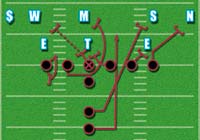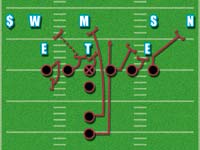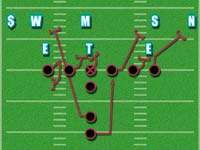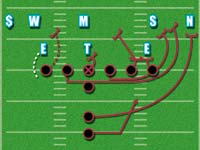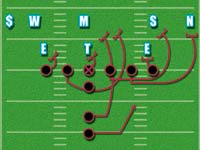Article CategoriesAFM Magazine
|
Attacking the 3-3 defense with the Inside and Outside Zoneby: Michael ChavezOffensive Line Coach, Southeast Missiouri State University © More from this issue On behalf of our staff at Southeast Missouri State University I’d like to say that it’s an honor and privilege to have the opportunity to share some of our thoughts and ideas on attacking the 3-3 Defense with the Inside and Outside Zone. The problem the 3-3 presents is that it is an odd front with a 4-3 linebacker set. It neither fits your odd front rules or your 4-3 rules and if you try to full zone it – more times than not – you come up empty-handed. It is because of this mix that we sat down as a staff and decided that if we were going to be a successful zone team against the 3-3 we would have to come up with a new set of rules that would allow us to cut off the defensive flow and still allow our running backs to be able to keep their zone reads. Through staff discussions and much film review it is our conclusion that in order to successfully attack the 3-3 you must be able to control the middle stack (nose guard and “Mike” linebacker). With that in mind, our schemes are designed to force the flow players to be fillers (Inside Zone) and to cut the flow players off by cutting the defense in half; making the force players hold or play flow (Outside Zone). Inside Zone In our system we have three simple calls that determine our blocking scheme: Bob, Mike and Home. Bob (Diagram 1)
This call directs the FB to attack the playside linebacker. The
TE and playside tackle will double-team the DE to the nickel backer.
Playside guard and center
will double team to the backside stack (nose guard and “Will” linebacker).
The backside guard will “wrap” around the double team to the “Mike” linebacker.
The backside tackle will “reach and revert” to control the backside
end. The RB will take a lateral step and read the “Mike” linebacker
for his cut.
Here the FB will be isolated on the “Mike” linebacker forcing him
to become a fill player. The playside tackle and TE will block the DE to nickel
backer with the playside guard gap-stepping out and working up to the “Sam” linebacker.
The backside guard will step to the center and “bump” the nose guard
enough for the center to get playside heavy at which time he will release to
the backside stack. As before, the backside tackle will “reach and revert.” The
RB will take the same lateral step as before reading the block on the “Mike” linebacker.
As an adjustment to our “Bob” and “Mike” calls, we will
make a “Home” call when we see that the linebackers are keying heavy
on our FB. This gives us a split flow look with the FB now stepping and releasing
up to the “Will” linebacker. The playside guard, tackle, and TE will
block as they do on a “Mike” call. The backside guard and center
will now work a “true” double team up to the “Mike” linebacker.
This call tells the FB he is leading into the alley looking to
block the nickel backer. The playside tackle and TE will double
the DE looking to come
off on
the first thing inside (usually the “Mike” linebacker, but can also
be the “Sam” linebacker if he walks up into the “B” gap).
The playside guard will pull around the double team for the “Sam” linebacker.
The center will be manned up with the backside guard pulling to get up
field as soon as he can look for the safety. The backside tackle will step
flat
with square shoulders and take the first thing to cross his face, DE or
backside linebacker. The RB will take a lateral crossover step reading
the DE. He
pushes
out, the
RB is underneath. He stays pinned, the RB will be outside.
As with our inside zone, this call will put our FB up on the “Mike” linebacker.
This is an especially good call for us if we have been successful running
the inside zone.
|
|
| HOME |
MAGAZINE |
SUBSCRIBE | ONLINE COLUMNISTS | COACHING VIDEOS |
Copyright 2024, AmericanFootballMonthly.com
All Rights Reserved


